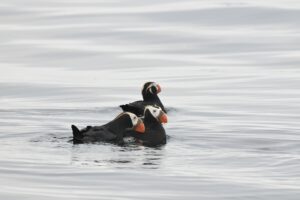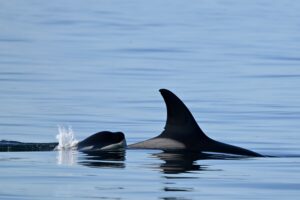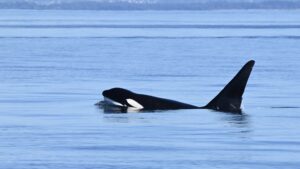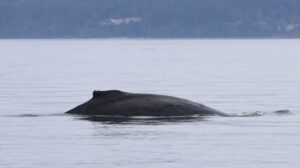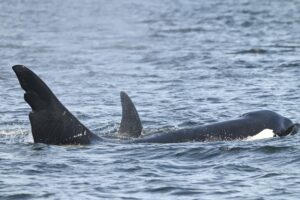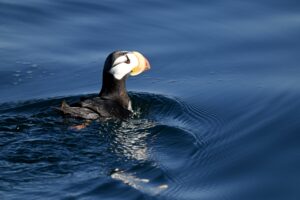As I sort through photos to recap this past week of whale sightings, we are starting to notice a slow shift on our afternoon tours. Instead of staying light into 9pm+, the sun has quietly started setting roughly 30-40 minutes sooner. The change brings cooler temperatures earlier into our afternoon trips and as the sun starts angling to the horizon sooner, lighting becomes a feature that can change the aesthetic dynamics we’re watching these whales in (golden hour light, darker backdrops with mercury water on overcast days, and etc.). This slow shift serves as a reminder to all of us to get out and enjoy summer while we still have the longer days and decent weather! Of course, the whales don’t mind, but pretty soon we’ll be adding an extra layer and coming back to the docks as the sun is going down. Where has peak summer gone already?!
Speaking of whales, this past week was pretty consistent with the three species we see around this time of the year.
Bigg’s killer whale families that were in our area this week, and that we personally encountered on our trips were: T19s (3), T36/36Bs (6), T37As (3), T46s (4), T46B1s (3) + T46C2 (1), T63 & T65 (2), T109As (6), and the T124Ds (4) have popped back into the central Salish Sea after spending most of the summer in other places (possibly SE Alaska?). This was 32 individual Bigg’s killer whales that guests were introduced to and got to spend some time watching. In most cases, as usual, many family groups were traveling, always scanning for marine mammal prey as they were going; in some cases, a couple of exciting hunts ensued! Naturalist Jenny got photos of the T46B1s and T46C2 on an epic harbor porpoise hunt that did turn a little graphic. Photos of that encounter are over on our socials at Instagram and Facebook (with content warning–though it’s really just some blood in the water and a pair of very clean harbor porpoise lungs on the surface). The squeamish may want to skip that part. It’s absolutely a treat to see a successful hunt–especially at the surface since most chasing and predating typically happens under water–and then some social behavior that can follow eating (think excited surfaces, spyhopping, tail slapping, rolling–sometimes a breach or two!). It sounds like guests really enjoyed that experience, and from chatting with Jenny, is something she won’t be forgetting anytime soon!
Humpbacks are still traveling through the islands to switch up their eating spots between the Strait of Georgia (up north and into BC) and the Strait of Juan de Fuca out west toward Victoria, Sooke, Sequim, and beyond. Sometimes they’ll also stick around for a few days to check out the menu around the islands. This past week we encountered humpback whale BCZ0345 “Victory” on several tours, and she was feeding around Salmon Bank and Hein Bank on those occasions. Two other humpback whales were spotted on this week’s tours as well, which are still awaiting some ID information through Happy Whale.
Minke whales were also seen on several of our tours, and one night we had both humpback whale BCZ0345 “Victory” and three Minkes feeding all within a mile of each other at Hein Bank. It becomes a “choose your own whale watching adventure” with whales off of all sides of the boat–and one of the best problems you can have–where to look?!
I also love a trip that is full of birds and this week we had some seasonal firsts. A parasitic jaeger was out around the Smith Island area where we scope for puffins, some small groups of red-necked phalaropes are beginning to make their way back into the central Salish Sea (typical for fall), and several red-necked grebes are showing up in bank-like areas (they will winter here with us, but lose the crimson-coloring around their necks that they’re named for during that time). While out at Smith Island watching a pair of Tufted Puffins, we had the rare Horned Puffin surface right next to the boat, from out of nowhere! If you’re a bird lover, or just “bird curious,” we’re coming up on a time of year where some of our summer visitors are still around, and fall migrants start passing through or moving into the Salish Sea to winter with us. Each day is different and sometimes turns up unexpected species.
As always, we are looking forward to seeing what the next week of wildlife sightings is going to bring us.

